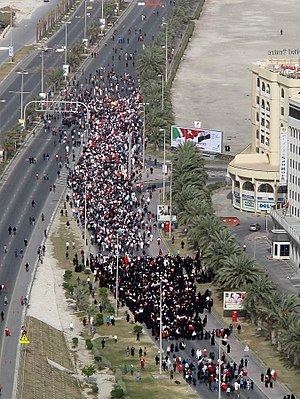 | ||
Results Suppression of Bahraini opposition demonstrators from 2011 until 2012, with GCC and Saudi support. | ||
Saudi led intervention in Bahrain's uprising began on 14 March 2011, three weeks after the U.S. pressured Bahrain to withdraw its military forces from the streets. As a decision by Gulf Cooperation Council (GCC), the intervention included sending 1,000 (1,200) troops with vehicles from Saudi at the invitation of the Al-Khalifa ruling family, marking the first time GCC used such a collective military option for suppressing a revolt.
Contents
Calling it both an occupation and a declaration of war, Bahrainis opposition pleaded for international help. The intervention was precedented by 1994 Saudi intervention in Bahrain.
Background
Bahrain protests began with the 14 February 2011 protest, mostly by the Shia Muslims making majority of Bahrain population, which faced immediate reaction from government. The protests initially sought greater political freedom and equality for the majority Shia population, and expanded to a call to end the monarchy of Hamad bin Isa Al Khalifa following a deadly night raid on 17 February 2011 against protesters at the Pearl Roundabout in Manama, known locally as Bloody Thursday.
Protesters blocked roads and their sheer numbers overwhelmed the Bahrain police. The government of Bahrain requested help from neighbouring countries. On 14 March, the Gulf Cooperation Council (GCC) agreed to deploy Peninsula Shield Force troops to Bahrain to secure key installations.
Units involved
GCC responded to the request from Bahrain's Al-Khalifa by sending its Peninsula Shield Force. The units sent from Saudi included 1,000 (1,200) troops along with 150 vehicles. The vehicles included "wheeled, light-armored vehicles with roof-mounted heavy machine guns." Saudi soldiers were apparently from Saudi Arabian National Guard, commanded by a son of King Abdullah, Prince Miteb. Also, 500 United Arab Emerites (UAE) policemen were sent via the causeway between Saudi Arabia and Bahrain. To protect the khalifas, Kuwaitis also "sent their navy to patrol the borders of" Bahrain, and some thousands were recruited from Pakistani "former servicemen", too.
By 2014, 5,000 Saudi and Emirati forces and almost 7,000 American forces were positioned "less than 10 miles from the Pearl Roundabout, the center of the country's protest movement."
Goals
Bahrain's strategic importance to Saudi Arabian government is originated from economic, sectarian and geopolitical reasons.
Sectarian & geopolitical goals
The real purpose of the intervention was to stop "a growing rebellion by the kingdom's majority, but deprived ... Shia citizens" by taking all necessary measures. Death of an Emirati policeman, Tariq al-Shehi, made it clear that the foreign troops were in fact involved in suppressing protests. According to Nuruzzaman, the most important factor leading to Saudi’s intervention in Bahrain, is "the domino effect of Bahrain's fall into Shia hands." Concerned about their own Shia population and fearful of democratic change, Saudi king Abdullah sought to reverse the pro-democracy movements in his neighbor countries using force. Saudi Arbia maintained that the cause of unrest in Saudi's eastern province, is the Shia uprising in Bahrain. According to Steffen Hertog, a Saudi Arabia expert at the London School of Economics and Political Science, Saudi's move was a signal to Shia movements in the Eastern Province to express how seriously Saudi intended to crack down the unrest. Moreover, keeping Al-Khalifa, "the key conservative Sunni ally of Saudi", in power was of notable importance to Saudi to avoid the spread of Iran's influence in west of Gulf. Saudi Arabia acted through GCC to mask its "strategic concern" about Iran and its influence.
As home of the United States Fifth Fleet, the events in Bahrain involved U.S. interests, too. Any Saudi departure from Bahrain and the assertion of Shia power would also directly affect U.S. interests and lead to weakening United States "military posture in the region".
Economic goals
The intervention was apparently carried out with the aim of guarding Bahrain's oil infrastructure. The two kingdoms have "strong" economical ties and Saudi Arabia had made significant investments in Bahrain's "tourism, infrastructure and some other industrial plans." Saudi Arabia, Bahrain's largest trading partner, sent troops to Bahrain to pursue some economic goals and among the important factors leading to sending troops to Bahrain were "the possibility of the loss of oil fields, terminals and crude processing plants, the loss of investment and future investment prospects." Moreover, any spill over of Bahrain's unrest into the neighbor kingdom would "upend" global oil markets.
Aftermath
Primarily interpreted by analysts "in terms of domestic and regional political and strategic dynamics," the intervention has created serious regional and global concerns and has turned the uprising into a regional cold war. Among other factors, the foreign military intervention may drive the sectarianism. According to Foreign Policy magazine, the intervention marked "a dramatic escalation of Bahrain’s political crisis."
